Inverse trigonometric functions
| Trigonometry |
|---|
|
| Reference |
| Laws and theorems |
| Calculus |
In mathematics, the inverse trigonometric functions (occasionally called cyclometric functions[1]) are the inverse functions of the trigonometric functions (with suitably restricted domains). Specifically, they are the inverses of the sine, cosine, tangent, cotangent, secant, and cosecant functions. They are used to obtain an angle from any of the angle's trigonometric ratios. Inverse trigonometric functions are widely used in engineering, navigation, physics, and geometry.
Notation
There are many notations used for the inverse trigonometric functions. The notations sin−1 (x), cos−1 (x), tan−1 (x), etc. are often used, but this convention logically conflicts with the common semantics for expressions like sin2 (x), which refer to numeric power rather than function composition, and therefore may result in confusion between multiplicative inverse and compositional inverse. Another convention used by some authors[2] is to use a majuscule (capital/upper-case) first letter along with a −1 superscript, e.g., Sin−1 (x), Cos−1 (x), etc., which avoids confusing them with the multiplicative inverse, which should be represented by sin−1 (x), cos−1 (x), etc. Yet another convention is to use an arc- prefix, so that the confusion with the −1 superscript is resolved completely, e.g., arcsin (x), arccos (x), etc. This convention is used throughout the article. In computer programming languages the inverse trigonometric functions are usually called asin, acos, atan.
Etymology of the arc- prefix
When measuring in radians, an angle of θ radians will correspond to an arc whose length is rθ, where r is the radius of the circle. Thus, in the unit circle, "the arc whose cosine is x" is the same as "the angle whose cosine is x", because the measure of the length of the arc of the circle in radii is the same as the measurement of the angle in radians.
Principal values
Since none of the six trigonometric functions are one-to-one, they are restricted in order to have inverse functions. Therefore the ranges of the inverse functions are proper subsets of the domains of the original functions
For example, using function in the sense of multivalued functions, just as the square root function y = √x could be defined from y2 = x, the function y = arcsin(x) is defined so that sin(y) = x. There are multiple numbers y such that sin(y) = x; for example, sin(0) = 0, but also sin(π) = 0, sin(2π) = 0, etc. It follows that the arcsine function is multivalued: arcsin(0) = 0, but also arcsin(0) = π, arcsin(0) = 2π, etc. When only one value is desired, the function may be restricted to its principal branch. With this restriction, for each x in the domain the expression arcsin(x) will evaluate only to a single value, called its principal value. These properties apply to all the inverse trigonometric functions.
The principal inverses are listed in the following table.
| Name | Usual notation | Definition | Domain of x for real result | Range of usual principal value (radians) |
Range of usual principal value (degrees) |
|---|---|---|---|---|---|
| arcsine | y = arcsin x | x = sin y | −1 ≤ x ≤ 1 | −π/2 ≤ y ≤ π/2 | −90° ≤ y ≤ 90° |
| arccosine | y = arccos x | x = cos y | −1 ≤ x ≤ 1 | 0 ≤ y ≤ π | 0° ≤ y ≤ 180° |
| arctangent | y = arctan x | x = tan y | all real numbers | −π/2 < y < π/2 | −90° < y < 90° |
| arccotangent | y = arccot x | x = cot y | all real numbers | 0 < y < π | 0° < y < 180° |
| arcsecant | y = arcsec x | x = sec y | x ≤ −1 or 1 ≤ x | 0 ≤ y < π/2 or π/2 < y ≤ π | 0° ≤ y < 90° or 90° < y ≤ 180° |
| arccosecant | y = arccsc x | x = csc y | x ≤ −1 or 1 ≤ x | −π/2 ≤ y < 0 or 0 < y ≤ π/2 | -90° ≤ y < 0° or 0° < y ≤ 90° |
If x is allowed to be a complex number, then the range of y applies only to its real part.
Relationships among the inverse trigonometric functions
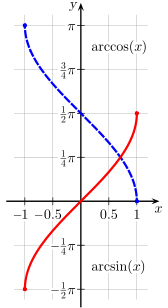
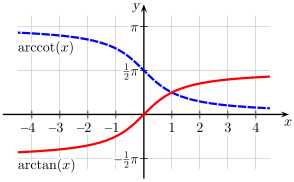
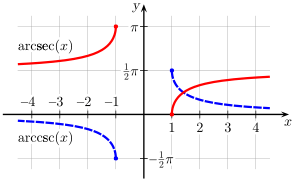
Complementary angles:
Negative arguments:
Reciprocal arguments:
If you only have a fragment of a sine table:
Whenever the square root of a complex number is used here, we choose the root with the positive real part (or positive imaginary part if the square was negative real).
From the half-angle formula  , we get:
, we get:
Relationships between trigonometric functions and inverse trigonometric functions
Trigonometric functions of inverse trigonometric functions are tabulated below. A quick way to derive them is by considering the geometry of a right-angled triangle, with one side of length 1, and another side of length x (any real number between 0 and 1), then applying the Pythagorean theorem and definitions the trigonometric ratios. Purely algebraic derivations are longer.
 |
 |
 |
 |
Diagram |
|---|---|---|---|---|
 |
 |
 |
 |
 |
 |
 |
 |
 |
 |
 |
 |
 |
 |
 |
 |
 |
 |
 |
 |
 |
 |
 |
 |
 |
 |
 |
 |
 |
 |
General solutions
Each of the trigonometric functions is periodic in the real part of its argument, running through all its values twice in each interval of 2π. Sine and cosecant begin their period at 2πk − π/2 (where k is an integer), finish it at 2πk + π/2, and then reverse themselves over 2πk + π/2 to 2πk + 3π/2. Cosine and secant begin their period at 2πk, finish it at 2πk + π, and then reverse themselves over 2πk + π to 2πk + 2π. Tangent begins its period at 2πk − π/2, finishes it at 2πk + π/2, and then repeats it (forward) over 2πk + π/2 to 2πk + 3π/2. Cotangent begins its period at 2πk, finishes it at 2πk + π, and then repeats it (forward) over 2πk + π to 2πk + 2π.
This periodicity is reflected in the general inverses where k is some integer:

- Which, written in one equation, is:


- Which, written in one equation, is:





Extension to complex plane
Since the inverse trigonometric functions are analytic functions, they can be extended from the real line to the complex plane. This results in functions with multiple sheets and branch points. One possible way of defining the extensions is:
where the part of the imaginary axis which does not lie strictly between −i and +i is the cut between the principal sheet and other sheets;
where (the square-root function has its cut along the negative real axis and) the part of the real axis which does not lie strictly between −1 and +1 is the cut between the principal sheet of arcsin and other sheets;
which has the same cut as arcsin;
which has the same cut as arctan;
where the part of the real axis between −1 and +1 inclusive is the cut between the principal sheet of arcsec and other sheets;
which has the same cut as arcsec.
Derivatives of inverse trigonometric functions
- Main article: Differentiation of trigonometric functions
The derivatives for complex values of z are as follows:
Only for real values of x:
For a sample derivation: if  , we get:
, we get:
Expression as definite integrals
Integrating the derivative and fixing the value at one point gives an expression for the inverse trigonometric function as a definite integral:
When x equals 1, the integrals with limited domains are improper integrals, but still well-defined.
Infinite series
Like the sine and cosine functions, the inverse trigonometric functions can be calculated using infinite series, as follows:
Leonhard Euler found a more efficient series for the arctangent, which is:
(Notice that the term in the sum for n = 0 is the empty product which is 1.)
Alternatively, this can be expressed:
Continued fractions for arctangent
Two alternatives to the power series for arctangent are these generalized continued fractions:
The second of these is valid in the cut complex plane. There are two cuts, from −i to the point at infinity, going down the imaginary axis, and from i to the point at infinity, going up the same axis. It works best for real numbers running from −1 to 1. The partial denominators are the odd natural numbers, and the partial numerators (after the first) are just (nz)2, with each perfect square appearing once. The first was developed by Leonhard Euler; the second by Carl Friedrich Gauss utilizing the Gaussian hypergeometric series.
Indefinite integrals of inverse trigonometric functions
For real and complex values of x:
For real x ≥ 1:
All of these can be derived using integration by parts and the simple derivative forms shown above.
Example
Using  , set
, set
Then
Then
and
Back-substitute for x to yield
Two-argument variant of arctangent
The two-argument atan2 function computes the arctangent of y / x given y and x, but with a range of (−π, π]. In other words, atan2(y, x) is the angle between the positive x-axis of a plane and the point (x, y) on it, with positive sign for counter-clockwise angles (upper half-plane, y > 0), and negative sign for clockwise angles (lower half-plane, y < 0). It was first introduced in many computer programming languages, but it is now also common in other fields of science and engineering.
In terms of the standard arctan function, that is with range of (−π/2, π/2), it can be expressed as follows:
It also equals the principal value of the argument of the complex number x + iy.
This function may also be defined using the tangent half-angle formulae as follows:
provided that either x > 0 or y ≠ 0. However this fails if given x ≤ 0 and y = 0 so the expression is unsuitable for computational use.
The above argument order (y, x) seems to be the most common, and in particular is used in ISO standards such as the C programming language, but a few authors may use the opposite convention (x, y) so some caution is warranted. These variations are detailed at Atan2.
Arctangent function with location parameter
In many applications the solution  of the equation
of the equation  is to come as close as possible to a given value
is to come as close as possible to a given value  . The adequate solution is produced by the parameter modified arctangent function
. The adequate solution is produced by the parameter modified arctangent function
The function  rounds to the nearest integer.
rounds to the nearest integer.
Logarithmic forms
These functions may also be expressed using complex logarithms. This extends in a natural fashion their domain to the complex plane.
Elementary proofs of these relations proceed via expansion to exponential forms of the trigonometric functions.
Example proof
Using the exponential definition of sine
one obtains
Let
Then
(the positive branch is chosen)
Example proof (variant 2)


- Apply the natural logarithm, multiply by -i and substitute theta.


 |
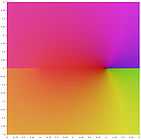 |
 |
 |
 |
 |
 |
 |
 |
 |
 |
 |
Arctangent addition formula
This is derived from the tangent addition formula
by letting
Application: finding the angle of a right triangle

Inverse trigonometric functions are useful when trying to determine the remaining two angles of a right triangle when the lengths of the sides of the triangle are known. Recalling the right-triangle definitions of sine, for example, it follows that
Often, the hypotenuse is unknown and would need to be calculated before using arcsine or arccosine using the Pythagorean Theorem:  where
where  is the length of the hypotenuse. Arctangent comes in handy in this situation, as the length of the hypotenuse is not needed.
is the length of the hypotenuse. Arctangent comes in handy in this situation, as the length of the hypotenuse is not needed.
For example, suppose a roof drops 8 feet as it runs out 20 feet. The roof makes an angle θ with the horizontal, where θ may be computed as follows:
Practical considerations
For angles near 0 and π, arccosine is ill-conditioned and will thus calculate the angle with reduced accuracy in a computer implementation (due to the limited number of digits). Similarly, arcsine is inaccurate for angles near −π/2 and π/2. To achieve full accuracy for all angles, arctangent or atan2 should be used for the implementation.
See also
- Argument (complex analysis)
- Complex logarithm
- Gauss's continued fraction
- Inverse hyperbolic function
- List of integrals of inverse trigonometric functions
- List of trigonometric identities
- Square root
- Tangent half-angle formula
- Trigonometric function
References
- ↑ For example Dörrie, Heinrich (1965). Triumph der Mathematik. Trans. David Antin. Dover. p. 69. ISBN 0-486-61348-8.
- ↑ Prof. Sanaullah Bhatti; Ch. Nawab-ud-Din, Ch. Bashir Ahmed, Dr. S. M. Yousuf, Dr. Allah Bukhsh Taheem (1999). "Differentiation of Tigonometric, Logarithmic and Exponential Functions". In Prof. Mohammad Maqbool Ellahi, Dr. Karamat Hussain Dar, Faheem Hussain. Calculus and Analytic Geometry (in Pakistani English) (First ed.). Lahore: Punjab Textbook Board. p. 140.
External links
- Weisstein, Eric W., "Inverse Trigonometric Functions", MathWorld.
- Weisstein, Eric W., "Inverse Tangent", MathWorld.




























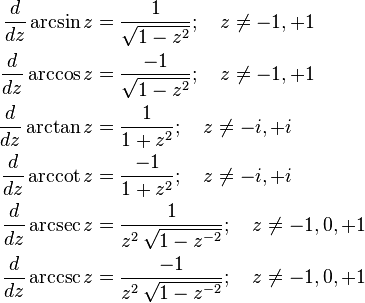


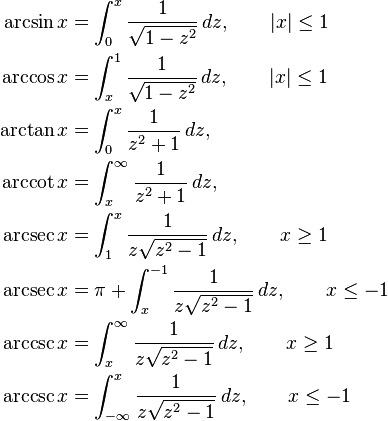









![{\begin{aligned}\int \arcsin x\,dx&{}=x\,\arcsin x+{\sqrt {1-x^{2}}}+C\\\int \arccos x\,dx&{}=x\,\arccos x-{\sqrt {1-x^{2}}}+C\\\int \arctan x\,dx&{}=x\,\arctan x-{\frac {1}{2}}\ln \left(1+x^{2}\right)+C\\\int \operatorname{arccot} x\,dx&{}=x\,\operatorname{arccot} x+{\frac {1}{2}}\ln \left(1+x^{2}\right)+C\\\int \operatorname{arcsec} x\,dx&{}=x\,\operatorname{arcsec} x-\ln \left[x\left(1+{\sqrt {{x^{2}-1} \over x^{2}}}\right)\right]+C\\\int \operatorname{arccsc} x\,dx&{}=x\,\operatorname{arccsc} x+\ln \left[x\left(1+{\sqrt {{x^{2}-1} \over x^{2}}}\right)\right]+C\end{aligned}}](/2014-wikipedia_en_all_02_2014/I/media/2/4/8/7/24871087fb97c95ae4b49b624bb9d86a.png)







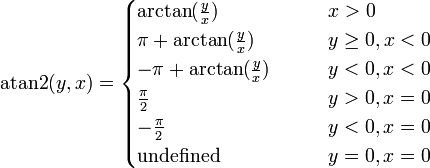


![{\begin{aligned}\arcsin x&{}=-i\,\ln \left(i\,x+{\sqrt {1-x^{2}}}\right)&{}=\operatorname{arccsc} {\frac {1}{x}}\\[10pt]\arccos x&{}=i\,\ln \left(x-i\,{\sqrt {1-x^{2}}}\right)={\frac {\pi }{2}}\,+i\ln \left(i\,x+{\sqrt {1-x^{2}}}\right)={\frac {\pi }{2}}-\arcsin x&{}=\operatorname{arcsec} {\frac {1}{x}}\\[10pt]\arctan x&{}={\tfrac {1}{2}}i\left(\ln \left(1-i\,x\right)-\ln \left(1+i\,x\right)\right)&{}=\operatorname{arccot} {\frac {1}{x}}\\[10pt]\operatorname{arccot} x&{}={\tfrac {1}{2}}i\left(\ln \left(1-{\frac {i}{x}}\right)-\ln \left(1+{\frac {i}{x}}\right)\right)&{}=\arctan {\frac {1}{x}}\\[10pt]\operatorname{arcsec} x&{}=-i\,\ln \left(i\,{\sqrt {1-{\frac {1}{x^{2}}}}}+{\frac {1}{x}}\right)=i\,\ln \left({\sqrt {1-{\frac {1}{x^{2}}}}}+{\frac {i}{x}}\right)+{\frac {\pi }{2}}={\frac {\pi }{2}}-\operatorname{arccsc} x&{}=\arccos {\frac {1}{x}}\\[10pt]\operatorname{arccsc} x&{}=-i\,\ln \left({\sqrt {1-{\frac {1}{x^{2}}}}}+{\frac {i}{x}}\right)&{}=\arcsin {\frac {1}{x}}\end{aligned}}](/2014-wikipedia_en_all_02_2014/I/media/3/c/9/2/3c92ee10ce68eab1cac6ccb53e48831c.png)



















